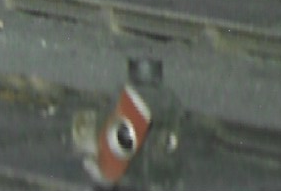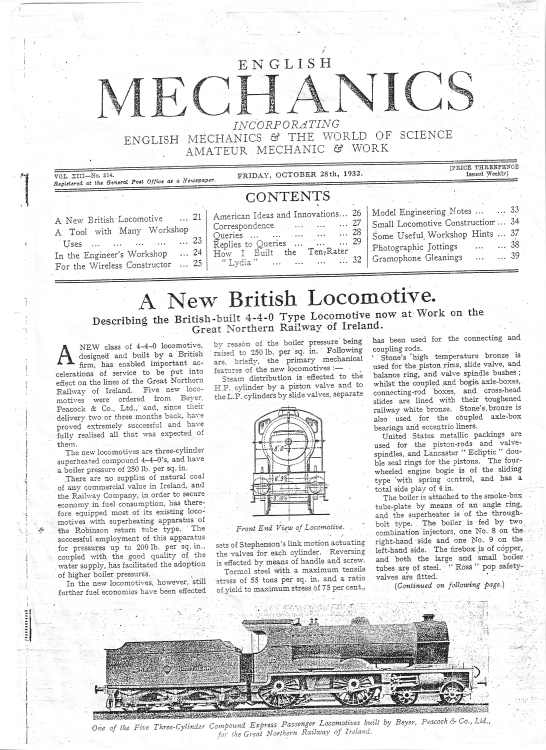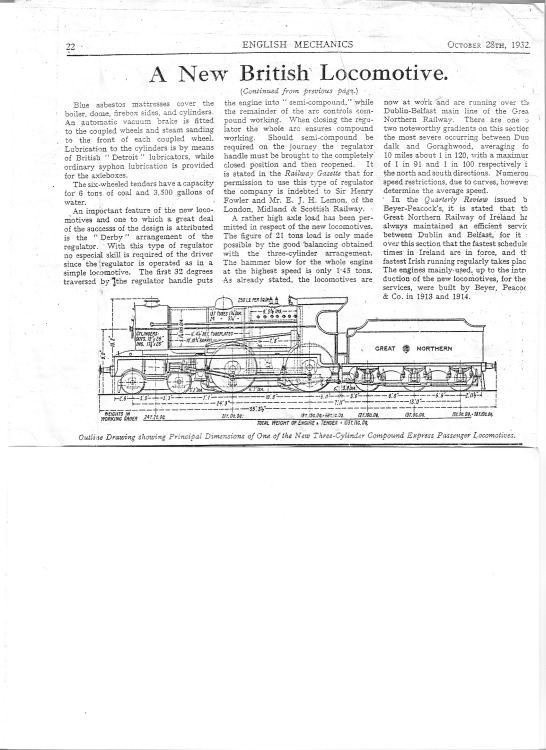
DSERetc
Members-
Posts
57 -
Joined
-
Last visited
-
Days Won
1
DSERetc last won the day on April 16 2020
DSERetc had the most liked content!
Recent Profile Visitors
The recent visitors block is disabled and is not being shown to other users.
DSERetc's Achievements
-
The last thing that intercity passengers (Sorry - customers) travelling between Belfast and Dublin need at present is more commuter stations between Dundalk and Drogheda or any where else along the line. In the late 1940s, a car could take up to 5 hours to make the journey, travelling at about 40 - 45mph and having to make its way through about 10 towns on the way. Then taking the train was usually the better choice. In response to an Aer Lingus proposal for a Dublin - Belfast service, in 1947 the GNRI started a non-stop express, leaving Belfast at 10.30 am and Dublin at 5.30 pm - the Enterprise Express taking 2 hours and 15 minutes. The journey still takes more or less the same time today, almost 80 years later. Today, the competition is the car and the bus on the new motorways, Belfast to Dublin Airport in 1 1/2 hours for example. We have a slow intercity service and a congested commuter service sharing the same railway line, built in the 1850s. After 175 years, could we afford to have new high speed lines serving Dublin - Belfast in 30 minutes at 300 mph and Dublin - Cork in 45 minutes, by-passing all other towns, and leave the existing lines to the commuter services and slower intercity trains and any new stations that are required. Would the cost of such high speed lines be much more than quadrupling the existing lines? However, would their income repay the investment in them? DSERetc
-
In the Journal of the Irish Railway Record Society, No 86 October 1981, in his article Sulzer Locomotives of CIE, on page 274 Dan Renehan writes 'Incidentally B107 and B106 were the only two to carry staff-snatchers, to my knowledge.' Also, I think it was in this forum that some one said that because because of the shape of the recesses on the locomotives, the staff-snatchers had to be installed facing in the wrong direction, so that the 'snatcher man' travelled in the rear cab to operate the arm. DSERetc
-
4012. There is no proof that I was there!
-
The first scheduled train departure from Belfast Grand Central Station was the 08.05 Enterprise service to Dublin. It departed from Platform 5. The consist was driving trailer 9004, first class 9102, catering vehicle 9403, standard class 9215, 9203, 9201, 9206, generating van 9604 and locomotive 206. The driver was Derek Weir. The train Manager, (conductor) (guard) was David Stewart. The first scheduled train to arrive at BGCS was the 08.30 Portadown to Belfast which also arrived at platform 5. CAF 4012. There is no proof that I was there!
-
Grand Central Station is claimed to be the largest 'Integrated' station in Ireland. It may be for passengers, (Sorry, Customers), living outside Belfast but not for those in Belfast. Passengers arriving into GCS on a Translink Ulsterbus or Gold liner (the blue buses), for example from Ballynahinch and wishing to go to Omagh will only have to walk from one bus stand to another in the same building. However Belfast residents using the Translink Metro bus (the pink city buses) or the Glider will still have to walk about a quarter of a mile to the station. That is hardly 'Integrated'! There are Glider and Metrobus stops just outside Lanyon Place station. Rail passengers will have to change trains if they want to continue their journey as the through Portadown - Bangor service is ended. At present, dropping off or picking up passengers by private car at GCS seems to be discouraged due to the distance that they have to walk to the station. {Note. There are at least two Metrobus services using GCS, one going to the George Best City Airport and another to the Stena Terminal.) DSERetc
-
In the late 1940s and first half of the 1950s, living in Bray, we had Byrnes, now the Irish Cancer Society on the Quinsborough Road. They were Hornby dealers and sold O gauge sets and accessories, The Locos were the tinplate 0-4-0 clockwork tender and tank engines, and four wheeled wagons and coaches. I was told in later years that Byrnes took instalment payments in the weeks and months before hand so that railway presents would appear on Christmas morning. They must of had Hornby Dublo but I cannot remember. Further down the street was GBH (Hammonds), now Auto and Trailer Parts, For some years they had a 'TRIX-TWIN circle of oo gauge ? track in the window and two engines running on it. Up at the top of the town near the town hall was Owens. If my memory is correct, at first, they sold cameras, model aeroplanes and cars and then later sold oo gauge trains. Going into Dublin on the Harcourt Street line, the first stop was the long narrow bicycle shop at the corner of Grafton Street and St Stephens Green that Mayner mentioned. I think the name of it was GEARYS. Then if it was just before Christmas, Switzers in Grafton Street had a layout on display in a window. There were also displays in Arnotts and Clearys windows. From Grafton Street up Dame Street and two or three shops before Georges Street was Healys. They had a model railway section and I remember drooling over an o gauge scale length bogie passenger coach in a display case. I have no idea who made it but the detail was marvellous compared to the Hornby tinplate four wheeled coaches. In the window of the B&I Shipping company in Westmoreland Street was a scale model about 3 or 4 feet long of MV Leinster or Munster ships. On the way to Amiens Street Station for the train back to Bray, the last stop was McHugh Himself under the bridge in Talbot Street. While not a model shop, there was a opportunity to look, drool and dream for some years at the RDS Spring Show trade exhibition at the CIE stand, but I seem to remember being disappointed that there was no model railway at the RDS Horse Show. I discovered many years later that the CIE display was set up by Cyril Fry. DSERetc
-
Did they not use something like milk of magnesite? I believe that it was not only the trains that ran regularly in Clogherhead! DSERetc
-
Will the GLIDER routes be adjusted to connect into the Grand Central Station?
-
Did Irish rail ever use the gangways in service? Say for example, Galway and Mayo trains combining at Athlone and opening the gangways to have access through the whole train? Fort William and Oban trains join and divide at Crianlarich on the West Highland line Perhaps as a compromise on the recent proposal for the Wexford line, more frequent four coach trains from Wexford or Rosslare with gangways front and back could be combined with similarly equipped new four car Darts at Greystones or Bray. No passenger transfers required.
-
-
These photos are from The Great Northern Railway (Ireland) in colour by Norman Johnston Colourpoint Books, Amiens Street Station. it includes rotating ground signals with a horizontal white 'on' or stop signal and a red 'off' angled signal also a back light for the on position. T
-
Congratulations! These are excellent models of Great Northern Railway signals. The white posts with the black cap and the spectacle plate the same colour as the signal arm. This was the practice of the GNR. On CIE and Irish Rail, the posts were white (or sometimes silver on round steel posts}, with the top of the post painted black down to about level with the bottom of the spectacle plate and the bottom of the post was also black to about three feet above the ground. The spectacle plate was painted white. On the GWR and on parts of British Rail, the spectacle plates were painted black. See the thread: Irish Railway Modeller/Questions and Answers/Irish Railway Signals, June 11, 2019
-
-
DSERetc started following Background information required
-
Could it be 186 on the Down line passing under Corbawn Lane, Shankill, Co Dublin, with the new Shankill Station {opened 10 June 1977) in the background before the DART upgrade? The date could possibly be 23/9/1978, there were three return trips Dublin - Bray ( Page 40 Steams Silver Lining, Joe Cassells) regards DSERetc
.png.c363cdf5c3fb7955cd92a55eb6dbbae0.png)


.png.6d0dbd52cdba911bd57b91d8ae14c4f2.png)

.thumb.png.74ffc5c90be80406918385b7574208d2.png)
.png.b2dd28521e00a1d4ee5490cc2efe6f05.png)
.thumb.png.a4a5368bb0a4d9bbc200828a67cbdd72.png)


